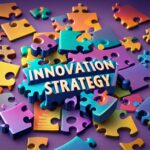This post is part of our series about innovation strategy. Check the main article for more detail!
In this post, we’ll dive into the fundamentals of innovation strategy, exploring what it is and why it’s crucial for businesses today.
Innovation Strategy: A Pathway to Business Success
What is Innovation Strategy?
Innovation strategy is a carefully crafted plan that organizations develop to foster innovation within their operations. It involves identifying opportunities for growth, change, and improvement, and then strategically allocating resources to make those opportunities a reality.
Why Is It Important?
Innovation strategy is essential because it keeps businesses relevant and adaptable. It enables companies to respond to market changes, new technologies, and evolving customer needs. By investing in innovation, organizations can differentiate themselves from competitors and achieve sustainable growth.
Objectives of Innovation Strategy
- Stay Competitive: Innovation strategy helps businesses maintain their competitive edge in the market.
- Adapt to Change: It allows organizations to adapt to changing market dynamics.
- Boost Creativity: Encourages creative thinking and idea generation.
- Optimize Resource Allocation: Ensures resources are allocated efficiently for innovation projects.
Example: Apple’s Innovation Success
A prime example of a company that has mastered innovation strategy is Apple. They have consistently introduced groundbreaking products and services, such as the iPhone and the App Store. Apple’s innovation strategy focuses on consumer needs, product design, and seamless user experiences. Their success demonstrates how a well-crafted innovation strategy can propel a company to the forefront of its industry.
What are the determining resources for innovation strategy?
Key Components of an Effective Innovation Strategy
Innovation strategy is not a one-size-fits-all approach. Instead, it’s a multi-faceted strategy that requires a carefully designed plan with several key components. In this post, we’ll dissect the essential elements that make up a successful innovation strategy.
Idea Generation
Effective innovation begins with idea generation. Encouraging employees and stakeholders to contribute ideas and suggestions is a fundamental component of innovation strategy. Whether through brainstorming sessions or open suggestion channels, collecting a diverse range of ideas is critical.
Market Analysis
Understanding your market and its dynamics is crucial. This component involves assessing market trends, customer behavior, and competitive landscape. It helps in identifying gaps or unmet needs that your innovations can address.
Resource Allocation
Resource allocation is the strategic distribution of funds, time, and manpower to various innovation projects. It’s essential to prioritize and invest in projects with the highest potential for success.
Risk Management
Innovation involves a degree of risk. Risk management is about assessing potential challenges and developing strategies to mitigate or overcome them. This ensures that innovation efforts are not derailed by unforeseen obstacles.
Example: Tesla’s Innovative Approach
Tesla, the electric vehicle pioneer, is a prime example of a company excelling in key components of innovation strategy. Their commitment to idea generation has led to advancements in battery technology, autonomous driving, and solar energy solutions. By conducting thorough market analysis, they’ve understood the need for sustainable transportation and renewable energy sources. Through effective resource allocation and risk management, Tesla has successfully disrupted the automotive industry.
Challenges and Barriers to Successful Innovation
Innovation is a powerful force, but it’s not without its challenges. When developing an innovation strategy, it’s essential to be aware of potential obstacles that may stand in your way. In this post, we’ll explore some common challenges and barriers to successful innovation.
Resistance to Change
One of the most significant challenges to innovation is resistance to change within an organization. Employees and stakeholders may be comfortable with the status quo and reluctant to embrace new ideas or processes.
Organizational Culture
A rigid or risk-averse organizational culture can stifle innovation. It’s crucial to create a culture that values creativity, experimentation, and learning from failure.
Lack of Resources
Innovation often requires investments in research, development, and new technologies. Limited resources can hinder innovation efforts.
Market Uncertainty
The unpredictable nature of markets can pose a challenge. Shifts in consumer preferences or economic downturns can impact the success of innovation projects.
Example: Kodak’s Failure to Adapt
Kodak’s story serves as a cautionary tale. Despite pioneering digital photography technology, the company failed to adapt to the digital age. It clung to its traditional film-based business model, and its resistance to change and inability to recognize market shifts led to its decline.
Measuring the Success of Innovation Strategies
Developing an innovation strategy is not enough; you must also measure its success. In this post, we will explore the metrics and key performance indicators (KPIs) that help organizations evaluate the effectiveness of their innovation strategies.
Return on Investment (ROI)
ROI is a crucial metric for measuring the financial success of innovation projects. It calculates the gain or loss generated from innovation investments.
Customer Feedback
Customer feedback is a valuable source of information. Positive feedback on new products or services indicates that your innovations are meeting customer needs.
Successful Product Launches
The number of successful product launches is an indicator of how well your innovation strategy is translating into real-world products that resonate with your target audience.
Time to Market
This metric measures how quickly you can turn innovative ideas into market-ready products or services. Faster time to market can give your organization a competitive advantage.
Example: Amazon’s Success Metrics
Amazon, known for its continuous innovation, uses customer-centric metrics to measure success. It tracks customer satisfaction, reviews, and sales growth for new products. If an innovation leads to increased sales and high customer ratings, it’s considered a success..
What Is Not an Innovation Strategy ?
Innovation strategy is a well-defined and structured approach to fostering creativity and driving growth. However, there are common misconceptions and practices that may appear to be innovation strategies but, in reality, fall short of the mark. Let’s explore what does not constitute a genuine innovation strategy:
1. Random Idea Generation
- Misconception: Some organizations believe that sporadic brainstorming sessions without a clear goal or direction qualify as an innovation strategy.
- Reality: True innovation strategy involves purposeful idea generation aligned with the organization’s objectives and market needs.
2. Imitating Competitors
- Misconception: Copying or imitating the innovations of competitors is often mistaken for innovation strategy.
- Reality: A genuine strategy focuses on unique, differentiated approaches that address specific challenges and opportunities.
3. Haphazard Resource Allocation
- Misconception: Allocating resources to innovation projects without a systematic assessment or prioritization.
- Reality: Effective innovation strategy carefully allocates resources to projects with the highest potential for success based on market analysis.
4. Neglecting Risk Management
- Misconception: Ignoring the risks associated with innovation and assuming that all projects will succeed.
- Reality: A well-crafted innovation strategy includes risk assessment and mitigation to ensure that challenges do not derail innovation efforts.
5. Lack of a Defined Vision
- Misconception: Failing to define clear objectives and a vision for innovation is not an effective strategy.
- Reality: An innovation strategy should be driven by a clear vision, goals, and a roadmap for achieving them.
6. Innovation Theater
- Misconception: Some organizations engage in superficial innovation activities for the sake of appearances.
- Reality: A genuine innovation strategy prioritizes meaningful and impactful innovation efforts over superficial gestures.
7. Ignoring Customer Feedback
- Misconception: Neglecting the voice of the customer and not incorporating their feedback into the innovation process.
- Reality: Customer feedback is a valuable component of innovation strategy, ensuring that innovations align with market needs.
8. Short-Term Focus
- Misconception: Concentrating solely on short-term gains and quick wins without considering long-term sustainability.
- Reality: An effective innovation strategy strikes a balance between short-term and long-term objectives, aiming for sustainable growth.
9. Treating Innovation as a One-Time Event
- Misconception: Viewing innovation as a singular project or event rather than an ongoing process.
- Reality: True innovation strategy recognizes that innovation is continuous and requires a long-term commitment.
10. Ignoring Organizational Culture
- Misconception: Overlooking the role of organizational culture in fostering or inhibiting innovation.
- Reality: A well-designed innovation strategy considers and shapes the organizational culture to support creativity and risk-taking.
By understanding what does not constitute an innovation strategy, organizations can avoid common pitfalls and misconceptions, paving the way for a more effective and impactful approach to innovation.
What are the determining resources for innovation strategy?
Video Explainers:
Innovation Strategy – What Is It and How Do You Create One?
What Is Strategy? It’s a Lot Simpler Than You Think by HBR
Video Explainers:
- Innovation Glossary
- A Guide to Developing Effective Innovation Strategies
- Communication Strategies for Innovation: A Guide to Getting Your Ideas Heard
About the authors
Dr. Alan Mitchell is a leading expert in innovation strategy, as a guest writer for our upcoming Innovation Strategy Series. With his extensive experience and practical insights, Dr. Mitchell will provide valuable guidance and thought-provoking content. Stay tuned for his expert insights as we explore the dynamic world of innovation strategy together.






